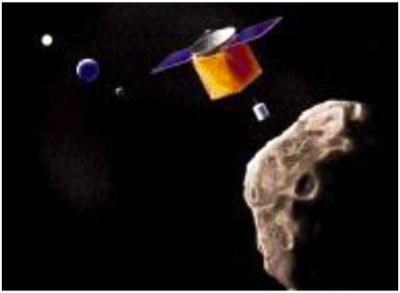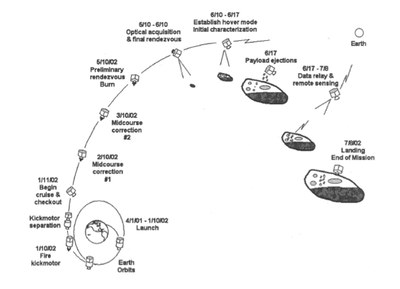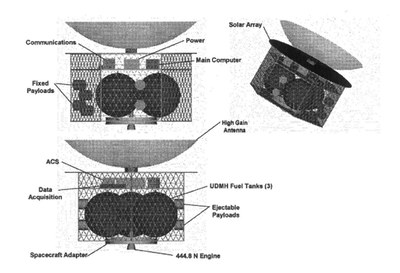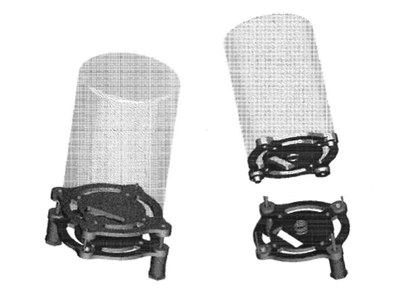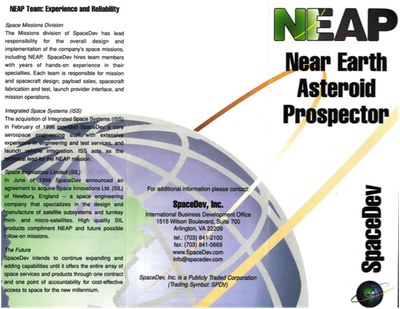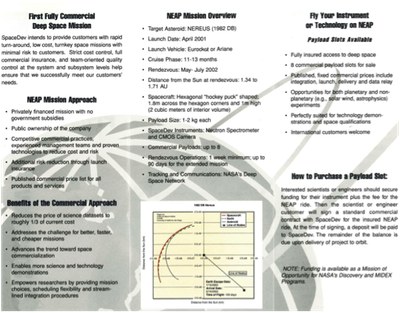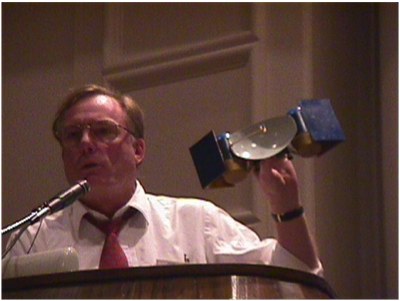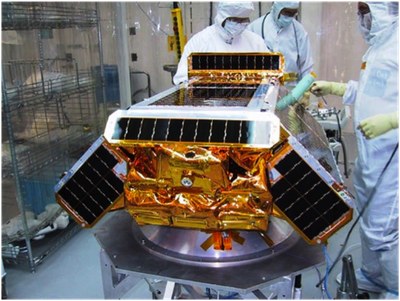NEAP: 15 years laterA new baselineA major invitation-only project review was scheduled for a Friday evening and full weekend, June 19–21, at The Inn at Laguna Beach, a vintage beachside hotel roughly midway between SpaceDev and JPL and not far from many of the other firms and individuals involved with the NEAP effort. Family members of the NEAP development team participants were encouraged to attend, and many did.
Benson charged Spear to “develop a NEAP project plan achieving consensus among all participants on project approach, cost, schedule, spacecraft approach and mass, and launch vehicle options and costs.”7
Spear was on track to retire from JPL at the end of June after 36 years there and was effectively focusing his attention on the NEAP effort. An accomplished no-nonsense, hands-on project manager and engineer, he felt that NEAP’s success hinged on SpaceDev leveraging the existing skills and insights concentrated at Caltech’s JPL and Johns Hopkins University’s Applied Physics Laboratory (APL). Both labs were actively implementing Goldin’s “Faster, Better, Cheaper” mantra with a series of deep-space science missions, often competing head-to-head for the limited NASA funds. For the planned NEAP review, Spear was able to attract the interest and support of some of the most experienced spacecraft, mission, and instrument engineers from JPL and APL, including several key project representatives from the mission most like NEAP, APL’s Near Earth Asteroid Rendezvous (NEAR). The NEAR spacecraft had been cruising in space for over two years and was months away from its planned rendezvous with the much larger near-Earth asteroid Eros. It was quite a coup to get all of these experts from rival labs together for a weekend of collaborative work. Some had to do it in secrecy to avoid ruffled feathers back at the office. To successfully steer the team toward the most innovative, cost-effective approach for NEAP, Spear had to get the development team to thoroughly discuss various engineering issues and uncertainties driving cost and schedule such as spacecraft redundancy approach, propulsion subsystem design, spacecraft mass estimate, other subsystem details, and launch-vehicle issues, then lay out the options and make some decisions. He showed a 27-month schedule from the review date until a launch-ready state in October 2000, including a formal project start October 1998, final design review four months later, and start of spacecraft assembly October 1999—aggressive, but not terribly unreasonable given the talent and experience of the people on the team and the planned streamlined development approach. Plus, there was a six-month pad at the end of the schedule until the earliest planned launch date for Nereus, in April 2001. During the kickoff session for the review on Friday night, Spear reminded everyone to think of the NEAP project as first in a planned series of SpaceDev missions and not as a one-off stunt. (If a one-off project, the temptation would be to “beg, borrow and steal” subsystem components from various sources to lower project costs—an unsustainable model.) He outlined the plans for the weekend, topic-by-topic, and ran through a long list of expected products to be generated by the end of the weekend, with specific responsible individuals. He also noted follow-up technical meetings with other JPL experts already planned for the week after, and committed to an ambitious due date for the review’s final report: June 29th. Spear also expressed concern about how SpaceDev was going to attract, utilize, and retain good people, given that the firm had no track record and a meager business base. To capitalize on the talents at JPL and APL, the review agenda followed a pattern where Spear himself or his hand-picked, world-class experts from the two labs would first provide their assessments of their respective technical or management specialties, followed by Smith and his ISS team (plus other NEAP consultants) weighing in with their points of view. Bob Farquhar, the principal mission designer for APL’s NEAR mission (also one of the most talented—and testy—trajectory designers on the planet), started the Saturday agenda (at 8 am!) with a summary of NEAP mission profile options, and was followed by ISS’s assessment. Several sessions addressing launch vehicle services, mission/quality assurance, and spacecraft topics completed the day. Sunday’s agenda addressed the mission’s ground data system, flight and ground software, mission operations issues, payload data product processing and visualization, and several hours of recap, conclusions, and assignment of action items.
The planned follow-up meetings were held after the review, completing detailed assessments of specific topics such as launch services, Nereus science-instrument investigation strategy, possibilities for Earth-viewing or even lunar science instrument candidates, how to close out the remaining loose ends of the “pre-project” phase, the spacecraft avionics architecture and flight software, and how to collaborate with JPL and APL on navigation and mission engineering.
As an example on the last topic, Bobby Williams, a deep-space navigation and maneuver planning expert at JPL and manager of the lab’s deep-space navigation group, provided a detailed cost estimate for what it would take to support SpaceDev’s NEAP navigation and maneuver planning effort over about four years if full collaboration with JPL and APL’s NEAR mission could be achieved. Williams’ group was leading the NEAR Nav effort on contract to APL and had all the insight needed. The result: about $1.5 million—plus or minus. The new total estimated cost for the mission came in at a bit less than $50 million: $30 million in procurements (including approximately $15 million for the launch service), about $12 million in staff labor, and another $5 million or so for project reserves. (In 2013 dollars this totals to about $70 million.) This was more than twice the sum Benson had estimated seven months before. The final baseline project schedule removed the six-month pad at the end of Spear’s original plan and slipped most of the key milestones accordingly, resulting in the pre-project phase from September 1998 through April 1999 followed by the two-year development phase. The Nereus launch-ready date held at April 2001. The market speaksWith the objectives of the Laguna Beach project review largely accomplished, Benson shifted into full marketing mode to secure NEAP data-buy contracts and payload reservations. An updated mission brochure was generated which incorporated the re-baselined mission and system details, shown below (credit: SpaceDev, 1998).
In the months following the review, Benson also focused much attention, energy, and capital on expanding SpaceDev’s key staff and core capabilities. In June, he hired Jan King, one of the most experienced small satellite engineers on the planet and a National Medal of Technology awardee, as Vice President of Space Engineering. Seeking a hook into international business, he also struck a deal in June to acquire a 40-employee UK-based spacecraft components firm, Space Innovations Ltd. This deal closed two months later. In July Rex Ridenoure, an ex-JPL mission engineer, project architect, and participant in NEAP studies during the previous year while at Microcosm, came onboard as Chief Mission Architect. (Months before he had played a catalytic role in the first—and still only—commercial lunar mission; see “Beyond GEO, commercially: 15 years… and counting”, The Space Review, May 13, 2013.) And in August, SpaceDev secured all intellectual property rights to the hybrid rocket-motor technology developed by the defunct American Rocket Company. (This AMROC technology served as the basis for the SpaceDev hybrid rocket motors eventually developed for thrusting the SpaceShipOne, SpaceShipTwo, and Dream Chaser vehicles.) The string of acquisitions targeted another key SpaceDev goal: achieve net tangible assets of at least $400 million so the firm’s stock could be listed on the more desirable and credible NASDAQ exchange.8 Providing impetus to the science community and potential SpaceDev investors for the new commercial model of exploration, in July a SpaceDev news release announced that two investigators had submitted proposals to NASA’s Discovery program to take advantage of the NEAP AO: a laser-altimeter instrument from Utah State University and a small robot explorer (a drop-can payload) from Carnegie Mellon University. Three other proposals to the MIDEX program were in work by the University of Iowa, University of California Berkeley, and the Southwest Research Institute. The most innovative instrument deal was announced in November 1998: an anticipated strategic agreement with the University of Arizona’s Lunar and Planetary Laboratory (Tucson) where the LPL would provide SpaceDev with two science instruments for NEAP—a Multi-Band CCD Camera and Neutron Spectrometer—for no charge to SpaceDev, while in return SpaceDev would waive the NEAP “ride fee” and later claim any revenue derived from science data generated by the instruments, with the university receiving a small cut. The camera deal was officially signed about four months later.
Another unprecedented milestone achieved by SpaceDev team during the late 1998-early 1999 period was that JPL’s Deep Space Network organization was put on contract by SpaceDev to factor the NEAP mission requirements into the ongoing advanced planning process for the DSN, an elaborate management process designed to sort out complex resource and scheduling requirements between the dozens of spacecraft tracked by the network. This was the first time a commercial deep-space mission had ever been entered into the DSN’s project databases and worked as a real mission. In August 1998, the US Securities and Exchange Commission (SEC) accused Benson of making false and misleading claims about this DSN agreement and NASA’s enthusiasm for NEAP—and about the expected near-term SpaceDev revenues derived from it. Benson, ever the salesman in public and prone to get a bit ahead of deals in work before the ink dries, replied that NEAP was “a serious effort and it’s being taken seriously by the scientific community” and that the SEC was “hunting for rabbits with an elephant gun.”9 By fall of 1998, the expanded SpaceDev team had gotten integrated and organized and began submitting proposals to NASA, the US Air Force, and National Reconnaissance Office for developing various small spacecraft and hybrid propulsion concepts, and by late 1998 and into 1999 and 2000 multiple significant spacecraft-related contracts were secured, providing more robustness to SpaceDev’s business base.
However, despite a number of proposal submissions to NASA by the science community, none of the NEAP Mission of Opportunity concepts for Discovery or MIDEX were funded by the agency, which irritated Benson tremendously. Because of this poor outcome—and especially because firm payload reservations and down payments would enable equity financing for the mission—the NEAP project lost momentum, stalled out, and never recovered. Benson speculated publicly that NASA bureaucrats who feared competition were stifling SpaceDev.10 He responded with an aggressive campaign to morph the NEAP mission model into lunar, asteroid, and Mars missions for purely commercial customers, holding advanced discussions with US media firms, private Japanese consortia, and even interested billionaires. In early 2000, SpaceDev and Boeing struck a strategic relationship to collaborate on such missions.11 But none of SpaceDev’s commercial deep-space mission concepts ever came to fruition. “The company wasn’t doing as well as he'd envisioned it,” Huntress recalled years later.4 “It was staying on its feet by being more practical than Jim was. They wanted to sell things to stay afloat, and he wanted to keep plowing into these visionary enterprises.” In the end, other contracts like the Mars Micromission concept studies and CHIPSat spacecraft job for NASA, and hybrid propulsion module design efforts for the Department of Defense, kept the staff engaged—and SpaceDev afloat.
CHIPSat was ultimately launched in 2003 and met all mission objectives. In 2004, SpaceDev’s hybrid rocket motors propelled the pioneering SpaceShipOne suborbital vehicle into space three times on its way to winning the X PRIZE, and it now hangs in the Smithsonian’s National Air and Space Museum. The Dream Chaser winged shuttlecraft concept was announced by Benson three weeks before the first of two X PRIZE flights.
SpaceDev’s 2005 acquisition of leading space-grade mechanisms supplier Starsys Research Corporation (Boulder, Colorado) added a solid yet more mundane business base to the company. SpaceDev’s transformation from a new maverick kid on the block to a more conventional diversified space systems firm was nearly complete. Benson stepped down as SpaceDev’s CEO in 2006 and immediately started Benson Space Company to market and operate a fleet of Dream Chaser vehicles in collaboration with SpaceDev, much like the original Virgin Galactic relationship with The Spaceship Company/Scaled Composites team. Benson suffered an untimely death from a brain tumor two years later. Ten days after his death it was announced that privately held Sierra Nevada Corporation would be acquiring SpaceDev, a transaction completed two months later. For posterityIn Tony Spear’s final report submitted to SpaceDev’s NEAP team following the Laguna Beach re-baseline review process, he eloquently captured the audacity of Benson’s vision and the inherent challenges a team faces when trying to implement such bold mission objectives as embodied in the NEAP concept:
References1 A version of Benson’s biography appears here: http://en.wikipedia.org/wiki/James_Benson. 2 A reverse acquisition (or reverse takeover, merger or IPO) is a legal technique for removing defunct public companies from whatever exchanges they trade on. A firm that wants to be public can acquire the shell of the defunct firm and eventually swap names. See more at http://en.wikipedia.org/wiki/Reverse_takeover. 3 The summary of this review comes from handouts collected and personal notes taken by the author, who attended the entire meeting as a representative of the space mission-engineering firm Microcosm, Inc. (Torrance, California). 4 2008 Oct 18: Jim Benson (1945 - 2008), “Rocket Man Ran a Proper Business, But Loftiest Plans Were Ill-Starred”; obituary for Benson, Wall Street Journal. 5 1998 Mar–Jun (multiple versions, with the final version dated Jun 15): SpaceDev Near-Earth Asteroid Prospector Mission-Specific Input for NASA/OSS Discovery and MIDEX Programs Mission of Opportunity Proposals; SpaceDev document ISS-HQ-98-032. 6 1998 Jun 8: “Entrepreneur Making Plans To Parlay Science Into Space-Age Gold Rush”; Article by David L. Chandler in the Boston Globe. 7 The summary of the Laguna Beach review also comes from handouts collected and personal notes taken by the author, who attended the entire meeting as a representative of the space mission-engineering firm Microcosm, Inc. (Torrance, California). 8 1998 Jul 27–Aug 2: “SpaceDev Acquisitions To Support NEAP Goals”; article by Brian Berger in Space News. 9 1998 Aug 7: “SEC Probes Space Fraud Case”; AP article by Marcy Gordon appearing in the Los Angeles Times. 10 Some good background material on SpaceDev and Benson can be found here: http://www.permanent.com/spacedev-neap.html. 11 A good summary of key events in SpaceDev’s evolution can be found in this 72-page SEC filing: http://www.secinfo.com/dV3p8.4dj.htm#c85. Home |
|
